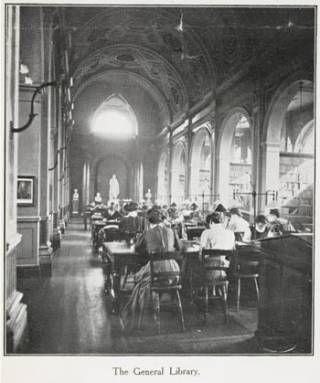A brief history of UCL Library Services, dating back to 1827 when the first UCL Librarian, Revd Dr Francis Augustus Cox, was appointed a year after the University was founded at Gower Street.

The first UCL Librarian, Revd Dr Francis Augustus Cox, was appointed in 1827, a year after the University was founded at Gower Street. The earliest library opened in the Wilkins Building just over a year later.
The first purpose-built General Library opened in 1849 and was later re-named after the Professor of Architecture who designed it, Thomas Leverton Donaldson.
In 1907 the Library expanded to take up the whole length of the first floor of the Wilkins Building and became the Main Library, still very popular with students today and often appearing in films and television programmes.
The Main Library primarily holds collections in the Arts & Humanities, and there is an equally large Science Library close by in Malet Place, which was once known as Upper Gower Mews, where the Tottenham Court Road department store James Shoolbred & Co. erected their workshops, warehouses and stables in the 1890s. After the store ceased trading in 1931 the buildings in this area were acquired by UCL for additional departmental and library space. Until 1967, The National Central Library (a forerunner of The British Library), and The Library Association were housed in what was then known as Chaucer House, but when the library moved into their space it was renamed the DMS Watson Building after David Meredith Seares Watson (1886-1973), Jodrell Professor of Zoology and Comparative Anatomy at UCL 1921-1951.
Following further expansion over the past century we now have many libraries supporting UCL's teaching and research, and a number of them provide services to both UCL and the NHS.
The Cruciform Hub is located in the former University College Hospital on Gower Street which was designed by Alfred Waterhouse and opened in 1906. It holds the combined collections of the former Clinical Sciences Library, and the Boldero Library which was attached to the Middlesex Hospital. Reading Medicine traces the development of these libraries up until they were merged in 2005.
The award-winning SSEES building in Taviton Street houses our School of Slavonic & East European Studies Library whose collections have been growing steadily since the School was founded in 1915, when it was established to study the new states appearing as a result of the collapse of the Austro-Hungarian and Russian Empires.
The Bartlett Library has its origins in two smaller libraries which served the separate departments of Architecture and Town Planning. When the Faculty of Environmental Studies was created in the early 1970s, the libraries were subsequently merged and the resulting Environmental Studies Library occupied the top floor of Wates House when it opened in 1974. It was later renamed and is now located in Central House. The Library holds materials on all aspects of the built environment and has extensive book collections and journal subscriptions. UCL is the only institution within the University of London with a department devoted to the study and design of the built world, hence the collections within the Bartlett Library are unique in this context.
The Institute of Archaeology was founded in 1937 and was originally housed at St John’s Lodge in Regents Park, but in 1958 it moved to Gordon Square as an independent institute within the University of London, until it joined UCL in 1986. The Institute of Archaeology Library was initially located on the first floor and subsequently moved to the fifth floor, and now contains the Yates Classical Archaeology Library and the prestigious Edwards Egyptology Library, making it one of the best archaeological collections in the world.
The Institute of Education was founded in 1902, as the London Day Training College. It occupied premises in Southampton Row, and these included a library. The first Librarian was appointed in 1925, and in 1932 the Institute became part of the University of London, and subsequently moved to occupy rooms in the North Wing of Senate House. In 1958 it moved to new 'temporary' premises in a large hut, next door to Senate House, which was originally built in 1918 to house Belgian refugees. By 1969 plans for the new building at Bedford Way designed by Denys Lasdun, including a library wing, were well under way. Meanwhile, the Library moved to another temporary space at 11-13 Ridgmount Street where it was to remain until 1991. When the new Institute building at 20 Bedford Way opened in 1975 it was only partially completed and the library was one aspect which was dropped from Lasdun’s original design. Under the leadership of Sir Peter Newsam the Institute finally succeeded in building an extension to its Bedford Way building to house the library and this opened in 1993, and on 2nd December 2014 the IOE Library joined the UCL family of libraries.
Our newest library opened in the Summer of 2024 as UCL East Library in Queen Elizabeth Olympic Park.
We also now manage spaces beyond our libraries such as the Student Centre and Graduate Hub, and appointments can be made to view our world class Special Collections, a rich source of manuscripts, archives and rare books.
Older material may be held in our Store in Wickford, Essex, and the team there sends requested material to our libraries on a daily basis.
 Close
Close

